CHA Tabard
Hart House
St. Bart's
Queen's Beasts
Canadian Heraldic Dictionary


| Term | Source | Meaning | Illustration |
| Cabbage | Morris, Fr. P.A., Vol VI, P 22 | The Cabbage alludes to the grantee’s German ancestry. |  |
| Caladrius | James, Keith. Vol V, P 96 |  The Caladrius is a mythical bird from the mediaeval bestiaries. It is a symbol of healing, and in this case alludes to the grantee’s profession as a physician. The Caladrius is a mythical bird from the mediaeval bestiaries. It is a symbol of healing, and in this case alludes to the grantee’s profession as a physician. |
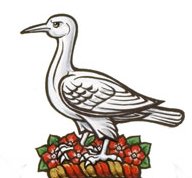 |
| Calipers | Land Forces Trials and Evaluations Unit. Vol IV, P 178 |  The Caliper is a measuring instrument, employed in carpentry and metal-work. Heraldically, it is used to signify the idea of measurement. The Caliper is a measuring instrument, employed in carpentry and metal-work. Heraldically, it is used to signify the idea of measurement. |
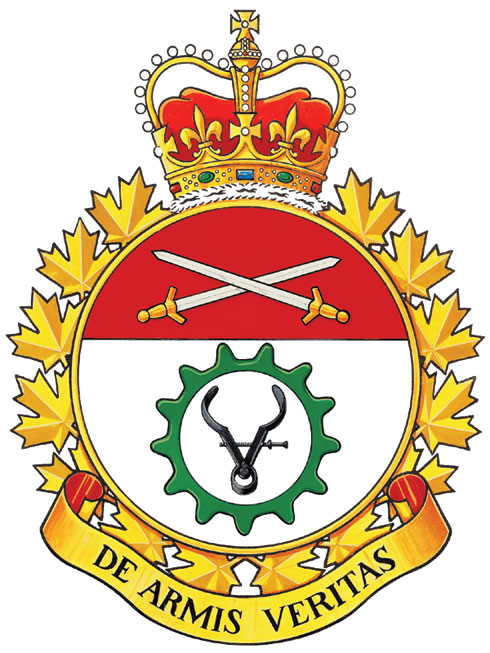 |
| Camera Iris | Imagery Technician. Vol VI, P 450 |  The Iris of a camera is used to control the amount of light coming through the lens. It is used here to allude to the idea of visual imagery. The Iris of a camera is used to control the amount of light coming through the lens. It is used here to allude to the idea of visual imagery. |
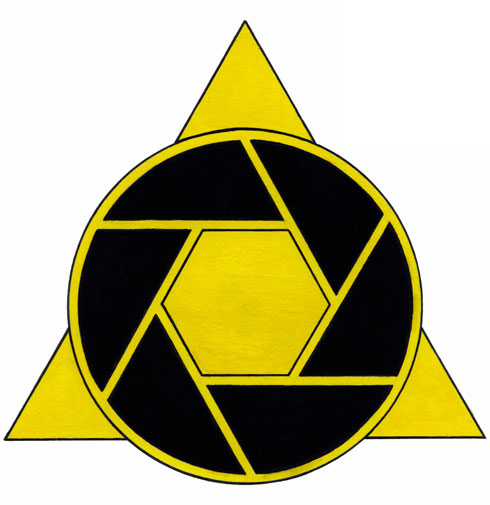 |
| Canada, Figure for | Dominion Institute. Vol IV, P 202 | The dexter supporter of these arms is known as the Figure for Canada, since it is an image of the allegorical figure of Canada on the Vimy Memorial in France. |  |
| Canada Goose | Gander, Nfld. | The bird most often associated with Canada. |  |
| Canadian Martlet | Cairns | A martlet depicted so that its wings and tail resemble a maple leaf (see also Maple Leaf Martlet, which is identical). |  |
| Canadian Astral Coronet | Can. Forces Aircrew Selection Centre. Vol III, P 393 | The coronet shown in the chief of this badge is known as the Canadian Astral Coronet. It consists of a circlet charged with estoiles, and bearing on its rim maple leaves alternating with conjoined pairs of wings. It signifies the ideas of Canada, flight and reaching for the stars. |  |
| Canadian Fess | District of Burnaby |  Following the lead of the Canadian pale (see below) the Canadian fess (an extra-wide fess) has followed. Following the lead of the Canadian pale (see below) the Canadian fess (an extra-wide fess) has followed. |
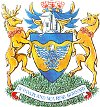 |
| Canadian Pale | N. William B. Rehder |  Originating with the Canadian flag, the Canadian pale (occupying one-half of the width of the flag or shield) has become popular in flags and the use has also been extended to shields. Originating with the Canadian flag, the Canadian pale (occupying one-half of the width of the flag or shield) has become popular in flags and the use has also been extended to shields. |
 |
| Canadian Star | Ontario Provincial Police (Orillia) Vol III, P 267 |  The Canadian Star is composed of the sun’s rays Argent issuant from a torteau. In this case it is charged with an open book proper. The Canadian Star is composed of the sun’s rays Argent issuant from a torteau. In this case it is charged with an open book proper. |
 |
| Cane, Walking | Olney, D.C. (Crest). Vol V, P 448 | The walking-cane, shown here in the crest, alludes to His Honour’s work as being a champion of people with disabilities. | 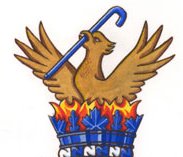 |
| Canterbury Cap | Cape Breton College | A red soft cap with a raised ridge in the centre. |  |
| Canoe | Synod of the Diocese of Saskatchewan, Vol V, P 45 |  The Canoe is the iconic North American form of watercraft, especially given its Native American associations. The Canoe is the iconic North American form of watercraft, especially given its Native American associations. |
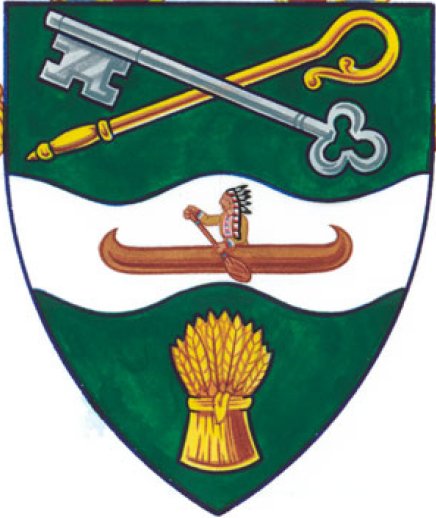 |
| Canoe Paddle | HMCS RADISSON, Vol II, P 13 |  The Canoe Paddle alludes to the means of travel of the Voyageurs in early Canada. The Canoe Paddle alludes to the means of travel of the Voyageurs in early Canada. |
 |
| Cantoned | London Police Service |  A term applied primarily to rectangular items such as banners. It refers to charges placed in the four corners of the field, as are the flower clusters shown here. A term applied primarily to rectangular items such as banners. It refers to charges placed in the four corners of the field, as are the flower clusters shown here. |
 |
| Cape | Dale, M.R.M., Vol I, P 77 |  The Black Cape, appearing in both arms and crest, is suggestive of the keeping of secrets or possibly association with a secret Order. The Black Cape, appearing in both arms and crest, is suggestive of the keeping of secrets or possibly association with a secret Order. |
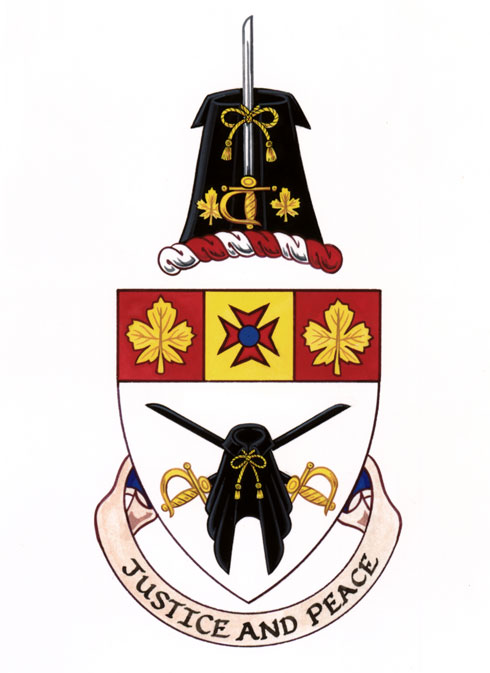 |
| Cape Breton Sloop | Cape Breton Regional Municipality, Vol III, P 166 |  The gaff-rigged Cape Breton Sloop alludes to the vessels used by fishermen in the early history of the Region. The gaff-rigged Cape Breton Sloop alludes to the vessels used by fishermen in the early history of the Region. |
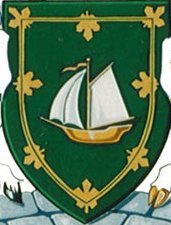 |
| Cape May Warbler | Parish of St. Philemon, Que., Vol IV, P 275 |  The supporters here show a pair of Cape May Warblers. These birds are common in Quebec, but also breed in most parts of Southern Canada. The supporters here show a pair of Cape May Warblers. These birds are common in Quebec, but also breed in most parts of Southern Canada. |
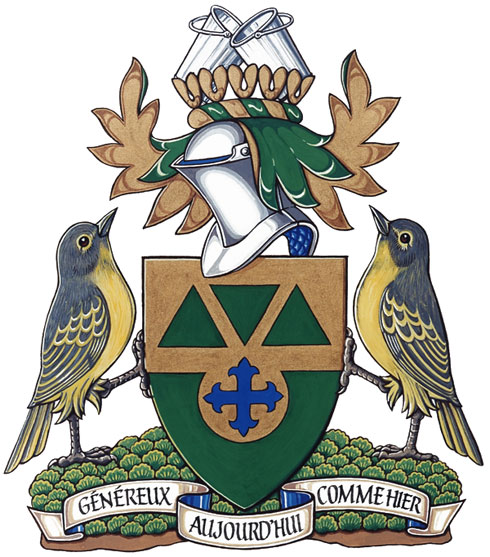 |
| Cardinal | Vachon, Auguste., Vol IV, P 111. |  The Cardinal is among the most colourful of Canadian birds. It is found throughout North America, mostly in open woodland. The Cardinal is among the most colourful of Canadian birds. It is found throughout North America, mostly in open woodland. |
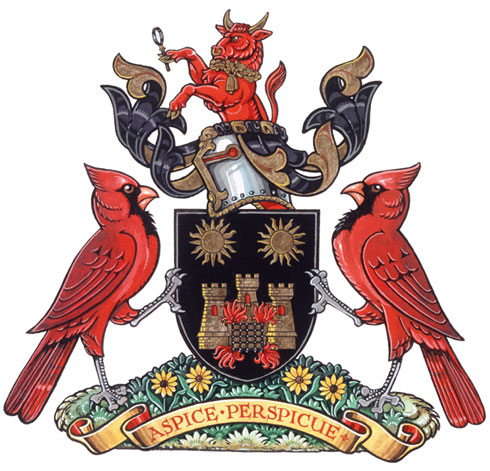 |
| Caribou | Van Bibber, G |  The ungulate of Northern North America, often associated with the Canadian Arctic regions. The ungulate of Northern North America, often associated with the Canadian Arctic regions. |
 |
| Carpenter's Square | Clarke, C. Joseph., Vol II, P 369 | The Carpenter’s Square is a tool, usually of steel, used by carpenters to establish right angles in their work. It conveys the idea that the grantee is a “builder’ by his service to the community. | 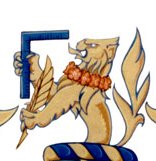 |
| Carrier Pigeon | Webb, A.K., Vol VI, P 352 |  The Carrier (or Homing) Pigeon is a bird that always returns to its place of origin. It was used to carry messages, famously in the First World War. The Carrier (or Homing) Pigeon is a bird that always returns to its place of origin. It was used to carry messages, famously in the First World War. |
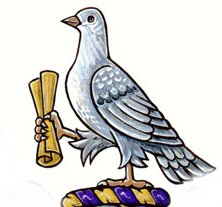 |
| Cathedra | St. Paul's Cathedral, Regina | The Cathedra or Bishop's chair was introduced into Canadian heraldry as the supporter for the arms of an Anglican cathedral, bearing additionally the arms of the diocese on the tympanum. It is no longer blazoned as a supporter but is considered as a form of display. |  |
| Chambered Nautilus | Dan, M.D., Vol VI, P 150 | The Chambered Nautilus is a mollusc of the warmer oceans, related to the octopus, clam and snail. The shell, when cut away, displays a nearly perfect equiangular spiral. |  |
| Chapé | Ville de Saint-Jerome, Vol IV, P 262 |  The Chapé noted in this blazon refers to the Argent area at the upper part of the shield, alluding to winter. Since the Chapé also resembles a partially open curtain, it is sometimes used to refer to the theatre or to drama in general. The Chapé noted in this blazon refers to the Argent area at the upper part of the shield, alluding to winter. Since the Chapé also resembles a partially open curtain, it is sometimes used to refer to the theatre or to drama in general. |
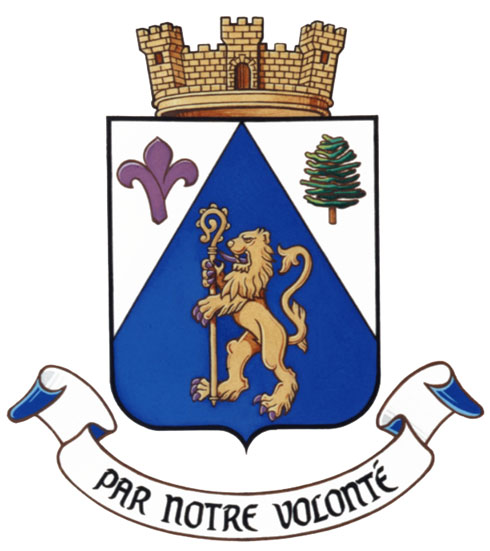 |
| Chapé embowed | Blizzard | The term chapé is defined in Friar as "parted per chevron enhanced", but the enhancement is not evident here. Since this very attractive figure resembling a curtain is commonly used for persons associated with the theatre, it might be worth creating it as a Canadian sub-ordinary in the depicted form (possibly called a "rideau") and using the more traditional blazon when the lines are straight. | 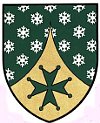 |
| Chimneys | Kirkegaard, P.G.M. Vol IV, P 7 |  The chimneys portrayed here are symbolic of heavy industry or manufacturing. The chimneys portrayed here are symbolic of heavy industry or manufacturing. |
 |
| Chinese Dragon | Pyke, J.F.A., Vol V, P515. |  The Dragon – seen here in demi form holding a pearl – is a mythical beast in Chinese culture. The Dragon – seen here in demi form holding a pearl – is a mythical beast in Chinese culture. |
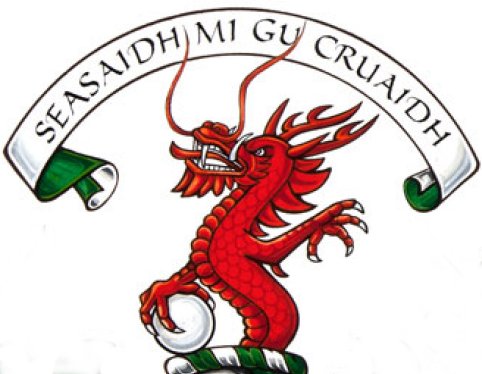 |
| Chinese Lion | Chui | This lion is also stylized, but in a very different manner from that of the European heraldic lion. | 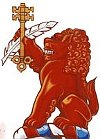 |
| Chinese Phoenix | Rt. Hon. Adrienne Clarkson | Again a stylized bird, but also different from the European version. | 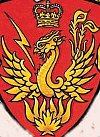 |
| Chinthe | 435 Transport and Rescue Squadron, RCAF. Vol VI, P 124 |  The Chinthe is a legendary lionine monster which guards temples in Burma, where the squadron operated in the Second World War. The Chinthe is a legendary lionine monster which guards temples in Burma, where the squadron operated in the Second World War. |
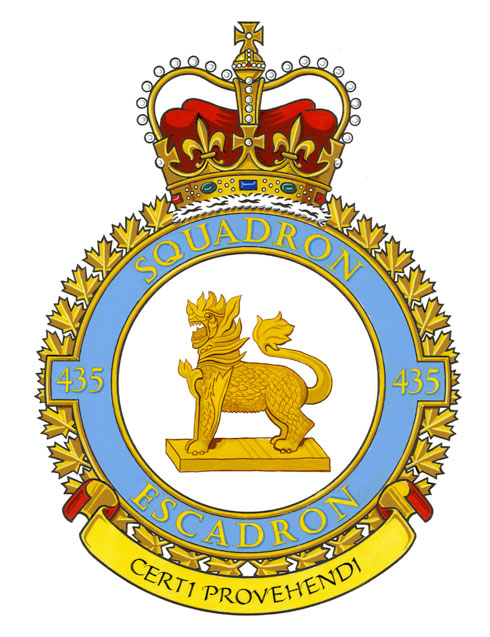 |
| Cicada | Ransom, R.E., (for daughter Katherine Julia) Vol V, P 67 |  The Cicada (shown here in the dexter chief) is an insect that belongs to the leafhopper family. It is known as the “tree cricket’, which might be a good nickname for an active little girl. The Cicada (shown here in the dexter chief) is an insect that belongs to the leafhopper family. It is known as the “tree cricket’, which might be a good nickname for an active little girl. |
 |
| Chi-Rho | Christ Church, Niagara Falls. Vol V, P 73 | The Chi-Rho, or sacred monogram of Christ, is frequently used as a religious symbol. It is made up of the two Greek letters Chi and Rho that begin the word Christ. | 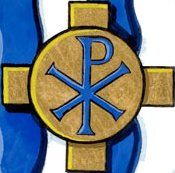 |
| Circular Saw Blade | Township of McNab/Brae-side.,Vol IV, P 70 | The Circular Saw Blade refers to the importance of the forest industries in Canada. | 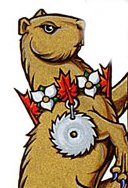 |
| Coal Car | City of Fernie, BC., Vol IV, P 341 | The Coal Car symbolizes the importance of the coal industry to the area of Fernie. | 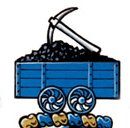 |
| Cobra | 444 Combat Support Squadron, RCAF., Vol VI, P 132 |  The Cobra is a venomous snake of Asia. The cobra, ready to strike, indicates the role of the unit as a fighter squadron. The Cobra is a venomous snake of Asia. The cobra, ready to strike, indicates the role of the unit as a fighter squadron. |
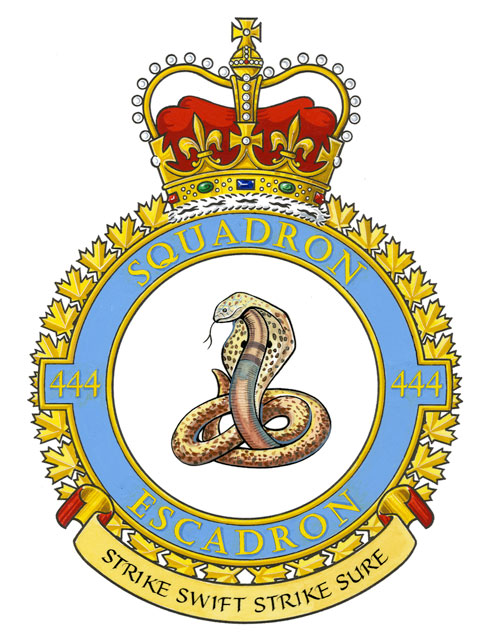 |
| Cochlea | Ling, D., Vol IV, P 154 | The Cochlea or snail shell is used in this case to represent the auditory portion of the inner ear, which it resembles. In this case, it refers to Dr. Ling’s work with deaf children. | 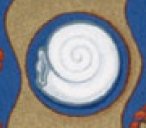 |
| Cocoa Pod | Purdy Chocolate Company. Vol V, P 4 | The Cocoa Pod is the source for raw chocolate, the source of the grantee’s product. |  |
| Cocoa Tree | Purdy Chocolates, Vol V, P 4 | The Cocoa (or Cacao) Tree, shown with its pods, is native to Central and South America. It is the source of chocolate. | 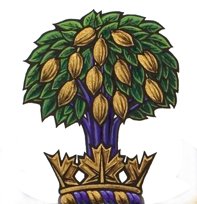 |
| Coffee Pot | Murchie’s Tea and Coffee, Ltd., Vol II, P230 | The Coffee Pot, used here for the first time in heraldry, is a familiar household utensil. It obviously refers to the grantee’s business. | 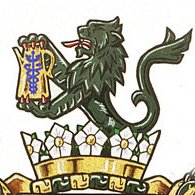 |
| Cog Wheel | Lougheed | The cog wheel (a steel wheel with squared projections on its outer edge) is often used to refer to persons or institutions associated with mechanical engineering (see also gear wheel, for which it is a synonym). | 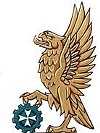 |
| Collie Dog | McAlpine, DA., Vol II, P 44 |  The Collie is a popular breed of dog, first bred in Scotland and used originally for herding cattle and sheep. The Collie is a popular breed of dog, first bred in Scotland and used originally for herding cattle and sheep. |
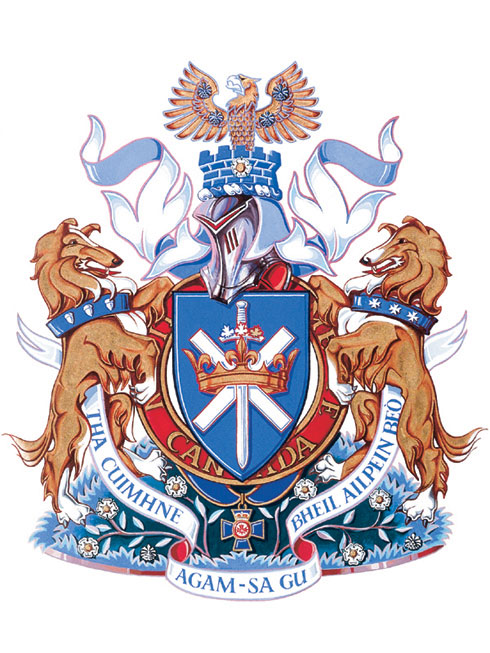 |
| Combine Harvester Knife | Town of Morinville, Alberta., Vol IV, P 281 |  The Combine Knife, shown here at the base of the compartment, is the primary part of a combine harvester, used in a reciprocal motion to cut grain. The Combine Knife, shown here at the base of the compartment, is the primary part of a combine harvester, used in a reciprocal motion to cut grain. |
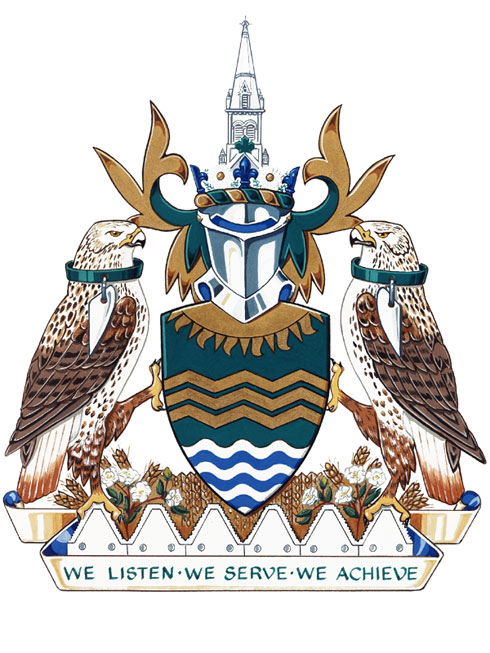 |
| Communications Satellite | House, A. M., Vol III, P 281 | The Communications Satellite is used here by a neurologist to suggest the communications provided by the human nervous system. It also refers to the Dr. House’s pioneering work in telemedicine. | 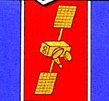 |
| Compass, Engineer's | Lewis, F.H. Vol VI, P 236 |  The Engineer’s Compass, in arms granted for the grantee’s son, refers to the idea of engineering or drafting. The Engineer’s Compass, in arms granted for the grantee’s son, refers to the idea of engineering or drafting. |
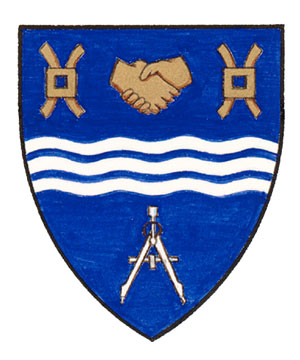 |
| Condor | Fernandez- Meyer, V.H., Vol VI 208 |  The Condor is a massive bird of the Andean regions of South America. It is used here to recognize the grantee’s birthplace in Chile. The Condor is a massive bird of the Andean regions of South America. It is used here to recognize the grantee’s birthplace in Chile. |
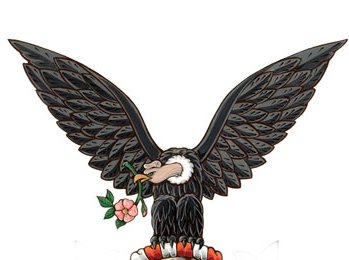 |
| Conestoga Wagon | 41 Service Battalion, Vol VI, P 365 |  The Conestoga Wagon is the heavy covered wagon used extensively in the US and Canada during the late 18th and early 19th centuries. It originated in the Conestoga region of Pennsylvania. It was also used for combat service support during the early history of the Canadian Army Service Corps. The Conestoga Wagon is the heavy covered wagon used extensively in the US and Canada during the late 18th and early 19th centuries. It originated in the Conestoga region of Pennsylvania. It was also used for combat service support during the early history of the Canadian Army Service Corps. |
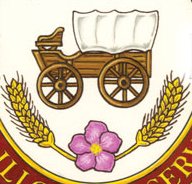 |
| Confucian Hat | Chui | Hat traditionally worn by Confucian scholars in China. |  |
| Constellation, Little Dipper | Norquay, JR. Vol IV, P 6 |  The Little Dipper, having the Pole Star at the end of its handle, suggests the name Norquay, meaning the Field of the North. The Little Dipper, having the Pole Star at the end of its handle, suggests the name Norquay, meaning the Field of the North. |
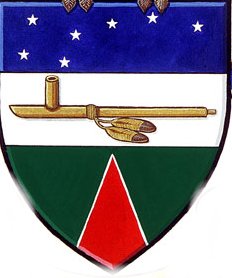 |
| Construct | Kiang | A useful term to describe a grouping of geometrical figures. That illustrated is blazoned as "a construct of five hexagons in saltire." |  |
| Copper (Tincture) | City of Whitehorse. Vol IV, P 253 |  The Copper tincture of the shield, (not used, as far as we can tell, in European heraldry) refers both to the historic mining of the mineral and its importance to the local economy, and also to the significance of the metal to the First Nations. The Copper tincture of the shield, (not used, as far as we can tell, in European heraldry) refers both to the historic mining of the mineral and its importance to the local economy, and also to the significance of the metal to the First Nations. |
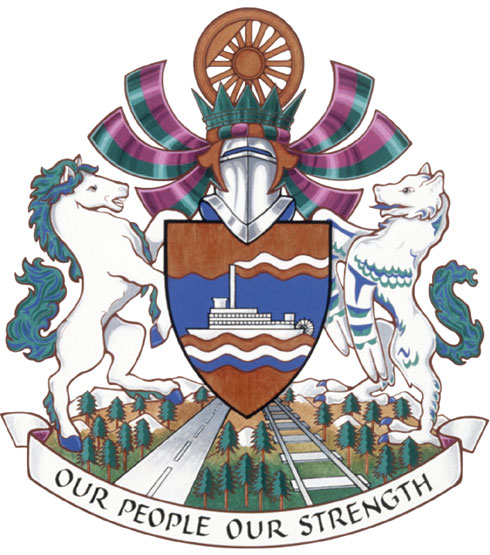 |
| Cormorant | Davis, S.M., Vol II, P 299 |  The Cormorant is a medium-to-large seabird with a long, thin, hooked bill and webbed feet. It is a fish-eater, catching its prey by diving from the surface. They are among the deepest divers of all sea-birds, being associated heraldically with SCUBA diving and other water-oriented sports. The Cormorant is a medium-to-large seabird with a long, thin, hooked bill and webbed feet. It is a fish-eater, catching its prey by diving from the surface. They are among the deepest divers of all sea-birds, being associated heraldically with SCUBA diving and other water-oriented sports. |
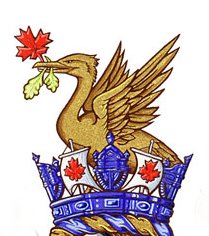 |
| Cornish Rex Cat | Robichaud, S., Vol VI, P270 |  The Cornish Rex is a breed of domestic cat with no hair except for down. It originates in Cornwall, England. The Cornish Rex is a breed of domestic cat with no hair except for down. It originates in Cornwall, England. |
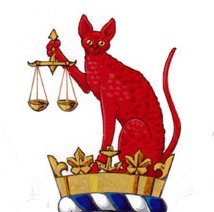 |
| Coronet Dancetty | City of Penticton | A coronet whose rim is heightened by a series of triangles, their bases in contact to resemble the partition-line dancetty. | 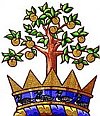 |
| Coronet Érablé | Heinricks | A coronet set with maple leaves, typically three visible. | 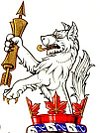 |
| Coronet, Loyalist Civil | John D. Hongisto |  A coronet showing three maple leaves alternating with two oak leaves. A coronet showing three maple leaves alternating with two oak leaves. |
 |
| Coronet, Loyalist Military | Mikel | A coronet showing maple leaves alternating with oak leaves between pairs of swords crossed in saltire. |  |
| Coronet, St. John | Harding |  A coronet set with Maltese crosses, typically three showing. A coronet set with Maltese crosses, typically three showing. |
 |
| Coronet Trefflé | Kervégant-Tanguy, C., Vol V, P476 |  The Coronet on which the lion is seated is rimmed by a circlet of trefoils, inspired by that of the Dukes of Brittany. The Coronet on which the lion is seated is rimmed by a circlet of trefoils, inspired by that of the Dukes of Brittany. |
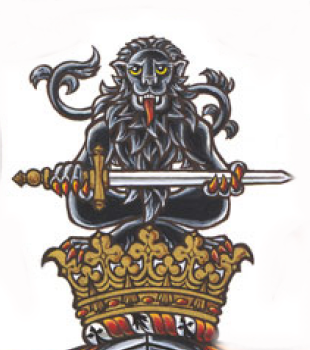 |
| Coronet of Wheat Spikes | Red Deer College, Alta., Vol IV, P 359 |  This unique coronet alludes to the wheat-fields of central Alberta. This unique coronet alludes to the wheat-fields of central Alberta. |
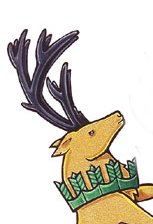 |
| Coronet of Snowflakes | City of Rossland, BC. (Crest) Vol III, P 145 | The Snowflake Coronet is a Canadian coronet that alludes to snow and winter in general, and to winter sports in particular. | 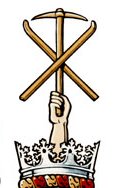 |
| Cotised | St. George's Society | "Argent a cross cotised by eight demi maple leaves Gules." This is a variant of the term cotised, which traditionally implies that an ordinary is accompanied by straight, narrow bands (diminutives of the ordinary in question). In Canadian practice, the cotises may be formed by the halves of a laterally symmetrical charge such as a fleur-de-lis, fir tree or (as in this case) a maple leaf. | 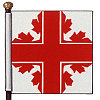 |
| Couched | Niagara Region | "… twelve chevrons couched dexter". This is variant Canadian usage of the term couched to refer to an ordinary lying on its side, since the term normally applies to animals (lying down with head up), or to shields (aslant). |  |
| Coureur de Bois | Ville de Lasalle, Quebec. Vol II, P 170 |  The Coureurs de Bois (runners of the woods) one seen here as the sinister supporter, were independent French-Canadian woodsmen who travelled in the wild country of New France. They were mostly involved with the fur trade and had frequent contact with the native population. Many were explorers and gained fame as such. The Coureurs de Bois (runners of the woods) one seen here as the sinister supporter, were independent French-Canadian woodsmen who travelled in the wild country of New France. They were mostly involved with the fur trade and had frequent contact with the native population. Many were explorers and gained fame as such. |
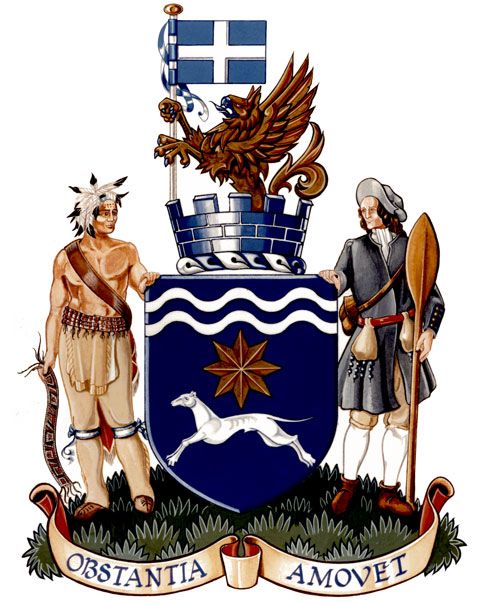 |
| Cowboy | Towers, T G. Vol II, P181 |  The Cowboy, shown on his horse in these arms, refers to the ranch country of Red Deer, Alberta, the grantee’s home. The Cowboy, shown on his horse in these arms, refers to the ranch country of Red Deer, Alberta, the grantee’s home. |
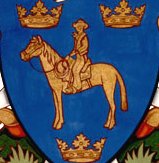 |
| Coyote | Town of Castor, AB. Vol VI, P62 |  The Coyote is an animal of the wolf family, widespread in North America. The Coyote is an animal of the wolf family, widespread in North America. |
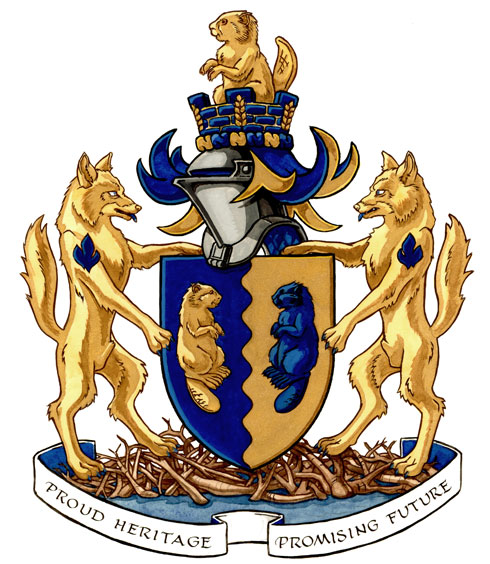 |
| Crab-Apple Tree | Crabtree, P.J. Vol IV, P 204 |  The Crab-apple tree is a rebus on the Grantee’s name. The Crab-apple tree is a rebus on the Grantee’s name. |
 |
| Crane, Sandhill | City of Pitt Meadows, BC. Vol V, P 305 |  The Sandhill Crane is shown as the sinister supporter of these arms. It suggests the rich riverside wildlife of the district. The Sandhill Crane is shown as the sinister supporter of these arms. It suggests the rich riverside wildlife of the district. |
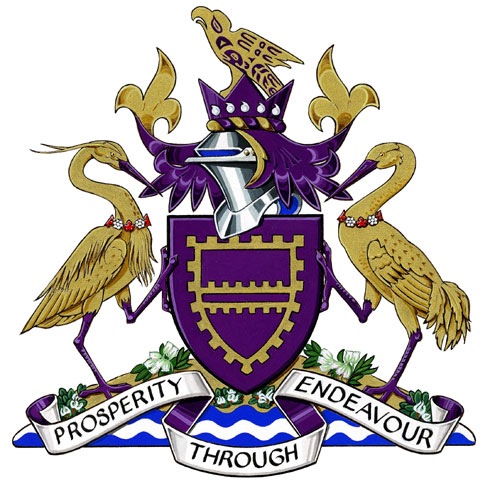 |
| Cree Warrior (c.1870's) | City of Prince Albert, Sask. Vol II, P 180 |  The Cree Warrior, shown here as the sinister supporter of Prince Albert’s arms, is dressed as he would have been in the 1870’s, with rawhide clothing and decorated cap with a long tail of eagle feathers. The Cree Warrior, shown here as the sinister supporter of Prince Albert’s arms, is dressed as he would have been in the 1870’s, with rawhide clothing and decorated cap with a long tail of eagle feathers. |
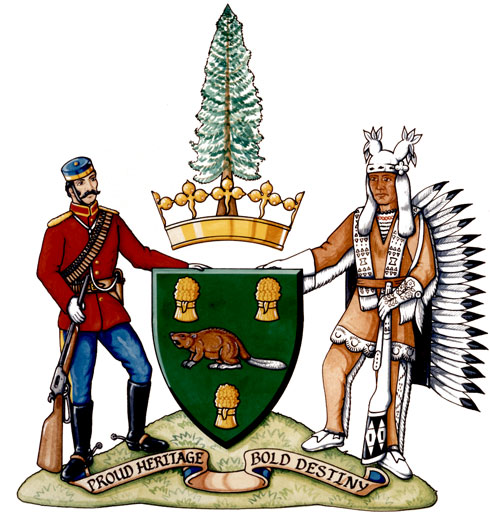 |
| Cree Warrior (c.1867) | Wetaskiwin, Alberta. Vol V, P 29 |  The Dexter supporter shows a warrior of the Cree Nation, commemorating the peace treaty between the Cree and the Blackfoot tribes in 1867. The Cree word wetaskiwin means Place of Peace. The Dexter supporter shows a warrior of the Cree Nation, commemorating the peace treaty between the Cree and the Blackfoot tribes in 1867. The Cree word wetaskiwin means Place of Peace. |
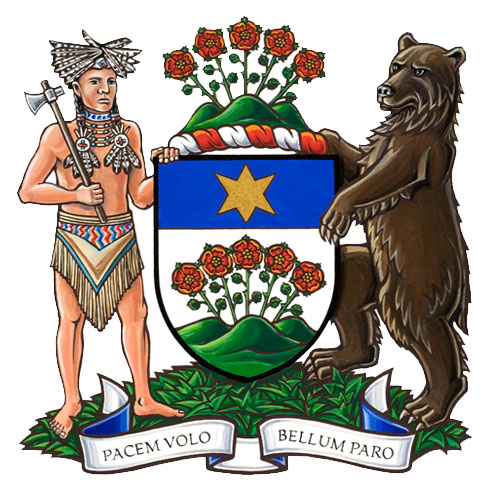 |
| Cricket Wicket | Toronto Cricket, Skating and Curling Club. Vol VI, P 278 |  Cricket is a game largely associated with England and the British Empire. The wicket (shown here in base) consists of three upright sticks. It stands behind the batsman and is the target of the bowler. Cricket is a game largely associated with England and the British Empire. The wicket (shown here in base) consists of three upright sticks. It stands behind the batsman and is the target of the bowler. |
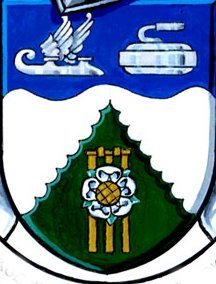 |
| Crochet | Asper | The quarter note, as shown in musical notation. |  |
| Crocus Flower | Winnipeg Police Service, (Badge). Vol II, P356 |  The Crocus Flower (specifically the prairie crocus, shown here) is the Provincial flower of Manitoba. The Crocus Flower (specifically the prairie crocus, shown here) is the Provincial flower of Manitoba. |
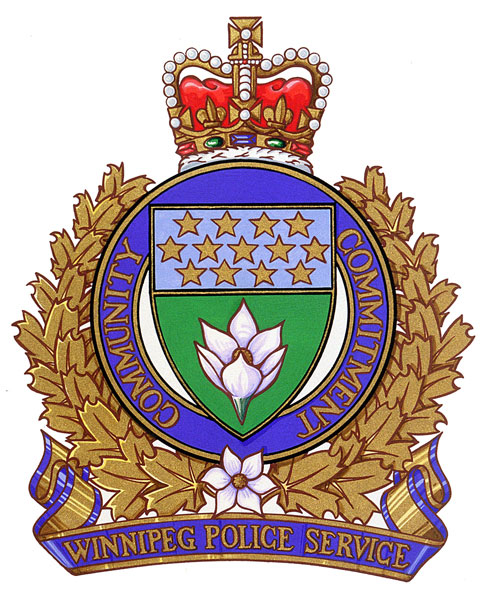 |
| Cross, Acadian Deportation | Robicheau, J.D.L., Vol VI, P 61 |  The Acadian Deportation Cross represents the famous monument in Grand Pré, Nova Scotia. It is used in this case to allude to the grantee’s Acadian heritage. The Acadian Deportation Cross represents the famous monument in Grand Pré, Nova Scotia. It is used in this case to allude to the grantee’s Acadian heritage. |
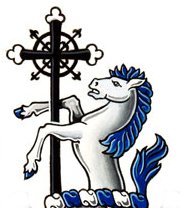 |
| Cross, Canterbury | Parson | This particularly attractive cross cannot, surprisingly, be found in any of the author’s references. It does, however, appear in a Canadian grant. |  |
| Cross Érablé | MacDonald, Rural Municipality | A cross whose three upper extremities terminate in maple leaves. |  |
| Cross Fretty | Fisher, H.G. | Again, this delightful cross could not be located outside its Canadian context. (The term fretty, as applied to a cross in the British texts, usually applies to one that is parted and whose parts are interlaced at the point of junction). | 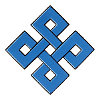 |
| Cross, Latin of Spearheads | Neilson | A unique cross used in a Canadian grant. | 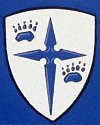 |
| Cross, Mission | Town of Midland | The Mission Cross has each arm terminating in spruce-tree shapes. It is used by communities originating as religious missions. | 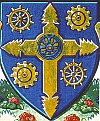 |
| Cross of the Society of Mary | Roussin, R.O., Vol IV, P360 |  The Cross of the Society of Mary consists of a Latin Cross conjoined with the letter M. The Cross of the Society of Mary consists of a Latin Cross conjoined with the letter M. |
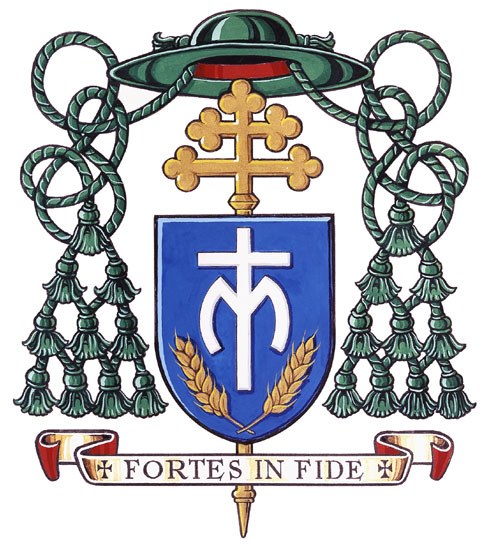 |
| Cross-Connect | MacDonald, R., Vol IV, P 272 |  The Crossconnect, (shown here charged on a Canadian pale) is a symbol used in telecommunications, to indicate a place where many lines come together for routing. The Crossconnect, (shown here charged on a Canadian pale) is a symbol used in telecommunications, to indicate a place where many lines come together for routing. |
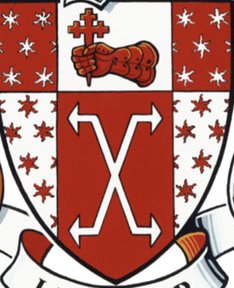 |
| Crosscut Saw | City of Kelowna, BC., Vol IV, P 89 | The saw in this crest alludes to the lumbering industry in early British Columbia. | 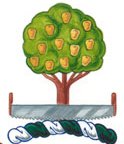 |
| Cross Pilawa | Hrycajkiw, AJ | This Polish cross resembles a cross patriarchal, but with an additional arm extending to sinister of the vertical member, forming “two and one-half of a cross”. It has historical rather than religious significance, commemorating the battle of Pilawa in 1166. It is used in the arms of a number of related Polish armorial "clans". |  |
| Crow - Tlingit Style | Gingell, J., Vol III, P 272 |  The dexter supporter in these arms depicts a crow, in the style of the Tlingit First Nation of the Yukon. The dexter supporter in these arms depicts a crow, in the style of the Tlingit First Nation of the Yukon. |
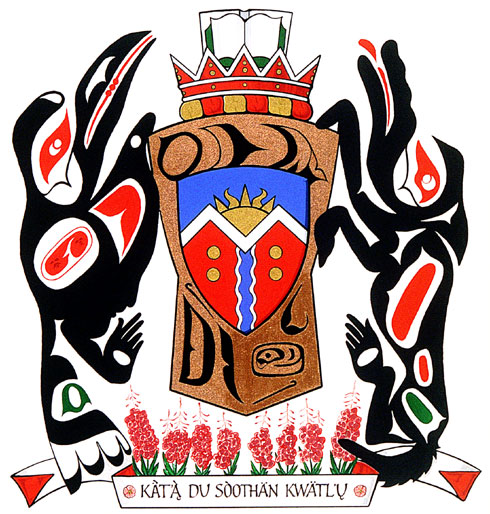 |
| Crucible | Corporation of Sault Ste. Marie. Vol VI, P 493 |  Crucibles (shown here in the compartment, with long handles held by the supporters) are used by steelworkers to hold molten steel for pouring. They symbolize the city’s steel-industry heritage. Crucibles (shown here in the compartment, with long handles held by the supporters) are used by steelworkers to hold molten steel for pouring. They symbolize the city’s steel-industry heritage. |
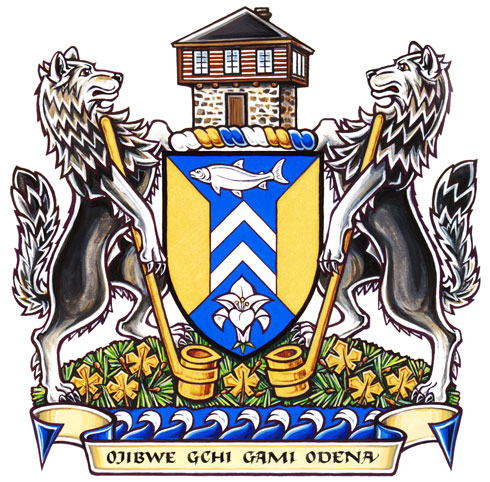 |
| Culinary Whisk | Thom, L.M.A., Vol IV, P 76 |  The Whisks – curiously alternating with pistols – refer here to the grantee’s expertise as a Cordon Bleu chef. The Whisks – curiously alternating with pistols – refer here to the grantee’s expertise as a Cordon Bleu chef. |
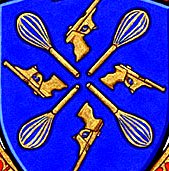 |
| Curling Stone | Toronto Cricket Skating and Curling Club. Vol VI P278 |  The Curling Stone, as shown in the sinister chief, used in this most Scottish of sports, particularly popular in Canada because of its long winters and number of Scottish settlers. The Curling Stone, as shown in the sinister chief, used in this most Scottish of sports, particularly popular in Canada because of its long winters and number of Scottish settlers. |
 |






